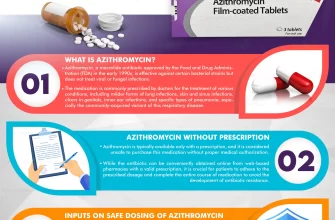If you need fluconazole, it’s possible to purchase it without a prescription. This antifungal medication is commonly used to treat a range of fungal infections, making it a practical choice for those experiencing symptoms without the immediate option of visiting a healthcare provider.
Research reliable online pharmacies that offer fluconazole for sale. It’s crucial to ensure that the pharmacy is licensed and provides genuine products. Look for customer reviews and check for verification seals to gauge legitimacy. Many online platforms will allow you to compare prices, which can be beneficial in finding the best deal.
Before purchasing, consider whether fluconazole is appropriate for your specific condition. While it is effective for many infections, consulting a healthcare professional for personalized advice is always wise. If you experience any side effects or have uncertainties about your health, don’t hesitate to reach out for medical guidance.
In summary, acquiring fluconazole without a prescription is possible, but it comes with responsibilities. Make informed choices, prioritize safety, and take charge of your health effectively.
- Buy Fluconazole Without a Prescription
- How to Find Reliable Sources
- Considerations Before Purchase
- Understanding Fluconazole and Its Uses
- Dosage and Administration
- Side Effects and Precautions
- Is It Legal to Buy Fluconazole Without a Prescription?
- Risks of Purchasing Fluconazole Without Medical Supervision
- Potential Side Effects
- Drug Interactions
- Where to Buy Fluconazole Online Safely
- How to Identify a Reputable Online Pharmacy
- Alternatives to Buying Fluconazole Without a Prescription
- Consult with a Healthcare Provider
- Explore Natural Remedies
- What to Consider Before Taking Fluconazole
- Potential Interactions
- Monitor for Side Effects
- Potential Side Effects and Interactions of Fluconazole
- Consulting a Healthcare Professional About Fluconazole
- Discuss Your Symptoms
- Review Medical History and Medications
Buy Fluconazole Without a Prescription
Purchasing fluconazole without a prescription is possible through various online pharmacies and health platforms. Look for licensed vendors that provide detailed information about the medication and have positive customer reviews. Always check that the pharmacy requires certain health information to ensure safety.
How to Find Reliable Sources
Seek online pharmacies that display clear contact information and a physical address. Verify their legitimacy by checking for certification from state or national pharmacy boards. Some platforms offer consultations with pharmacists who can guide you through safe purchasing processes.
Considerations Before Purchase
Review possible side effects and interactions with other medications you may be taking. It’s advisable to consult reputable health resources or a healthcare professional before making a purchase. Knowing the correct dosage is also critical; typically, it comes in 150 mg doses for treating fungal infections.
Ensure you have a method to contact customer support for any inquiries regarding your order. This step adds an element of trust to your purchase. Keeping track of your symptoms post-treatment will help in assessing the medication’s effectiveness.
Understanding Fluconazole and Its Uses
Fluconazole is an antifungal medication primarily used to treat fungal infections, particularly those caused by Candida species. It is effective against infections in various parts of the body, including the mouth, throat, esophagus, bloodstream, and genital area. Healthcare providers often prescribe fluconazole for conditions such as candidiasis, cryptococcal meningitis, and as a preventative measure in patients with weakened immune systems.
Dosage and Administration
The dosage of fluconazole depends on the type and severity of the infection. For candidiasis, a common starting dose might be 150 mg as a single oral dose, while more severe infections may require higher doses or longer treatment durations. It’s important to follow the healthcare provider’s directions closely. Patients should take the medication with a full glass of water, and it can be taken with or without food.
Side Effects and Precautions
Fluconazole is generally well tolerated, but some individuals may experience side effects such as nausea, headache, dizziness, or abdominal pain. More serious side effects can occur, including liver toxicity or severe allergic reactions. Individuals with liver disease, allergies to azole antifungals, or those taking certain medications should consult their healthcare provider before use. Regular monitoring may be necessary for long-term users to ensure safety and effectiveness.
Is It Legal to Buy Fluconazole Without a Prescription?
In many countries, purchasing fluconazole over the counter without a prescription is not permitted. Regulations typically require a prescription for antifungal medications to ensure proper medical guidance and to manage the risk of misuse.
In some jurisdictions, low-dose fluconazole may be available without a prescription, but this is not universal. It’s crucial to check the specific laws and regulations in your region regarding fluconazole.
If you consider obtaining fluconazole without a prescription, consult your local pharmacy or healthcare provider first. They can confirm the legal status and guide you through safe options for treatment.
| Country | Prescription Requirement |
|---|---|
| United States | Prescription required |
| Canada | Prescription required |
| United Kingdom | Prescription required |
| Australia | Prescription required |
| Mexico | Available over the counter |
It’s paramount to use medications responsibly. If you believe fluconazole is necessary for your condition, obtaining it legally and with proper medical advice is the best approach. Always prioritize your health and safety.
Risks of Purchasing Fluconazole Without Medical Supervision
Buying fluconazole without medical supervision can lead to serious health risks. Understanding these risks is crucial for making informed decisions.
Potential Side Effects
- Common side effects include headache, dizziness, and gastrointestinal issues.
- Severe allergic reactions, such as rash, itching, or swelling, may occur.
- Prolonged use without guidance can result in liver damage or other organ complications.
Drug Interactions
Fluconazole can interact with various medications. Consult a healthcare professional to avoid harmful combinations. Ignoring this advice may lead to:
- Increased toxicity of other drugs.
- Reduced effectiveness of essential medications.
- Complications in managing existing health conditions.
Ultimately, secure your health by seeking guidance from a healthcare provider before purchasing fluconazole. Their expertise ensures safety and appropriate treatment.
Where to Buy Fluconazole Online Safely
Purchase fluconazole from reputable online pharmacies that require a prescription. Start by checking for pharmacies accredited by organizations like the National Association of Boards of Pharmacy (NABP) or the Verified Internet Pharmacy Practice Sites (VIPPS). These accreditations ensure the pharmacy operates legally and prioritizes patient safety.
Look for pharmacies with a licensed pharmacist available to answer questions about the medication. A trusted online pharmacy should provide clear contact information and be transparent about their licensing and regulatory compliance.
Read customer reviews and ratings to gauge the experiences of other buyers. Positive feedback can indicate reliability, while numerous complaints may signal potential issues. Websites like Trustpilot or the Better Business Bureau can help assess a pharmacy’s reputation.
Always verify that the pharmacy provides secure payment options. Ensure that the website has encryption for protecting your personal and payment information. Look for indicators such as “https” in the URL and recognizable payment methods.
Be cautious of prices that seem unusually low, as they may indicate counterfeit medications. Compare prices across different sites to determine a fair market rate for fluconazole.
If unsure about a particular pharmacy, consult your healthcare provider for recommendations. They may suggest reputable online options or confirm whether a specific site is trustworthy.
By following these recommendations, you can buy fluconazole online securely and with confidence.
How to Identify a Reputable Online Pharmacy
Check for a physical address and phone number on the website. Legitimate pharmacies provide clear contact information.
- Verify the pharmacy’s licensing. Look for the appropriate regulatory body in your country that oversees online pharmacies.
- Ensure the pharmacy requires a prescription. A reputable pharmacy will always ask for a valid prescription from a licensed healthcare provider.
- Look for a pharmacy seal. Trustworthy online pharmacies often display certification seals from organizations like the National Association of Boards of Pharmacy or other local equivalents.
- Research customer reviews. Independent websites and forums can provide insights into others’ experiences with the pharmacy.
- Check for secure payment options. Look for clear, secure methods for online transactions, such as SSL encryption.
Assess the website’s professionalism. A well-designed site with clear policies reflects credibility. Review the privacy and return policies carefully.
- Contact customer service. Reach out with questions; genuine pharmacies should respond promptly and knowledgeably.
- Be cautious of unusually low prices. If prices seem too good to be true, investigate further.
- Evaluate product information. Authentic pharmacies provide comprehensive details about medications, including side effects and interactions.
Trust your instincts. If something feels off, it’s best to explore other options. Your health is too important to compromise.
Alternatives to Buying Fluconazole Without a Prescription
Consider over-the-counter antifungal treatments like clotrimazole or miconazole. These medications effectively target similar yeast infections and are readily available at pharmacies. Always read product labels and follow the recommended usage instructions for the best results.
Consult with a Healthcare Provider
If you suspect a fungal infection, discussing symptoms with a healthcare provider is wise. They may offer guidance or prescribe appropriate treatment based on your condition. This ensures you receive the right medication for your specific needs.
Explore Natural Remedies
Look into natural options such as tea tree oil or garlic, known for their antifungal properties. Dilute tea tree oil with a carrier oil before applying it to the affected area. Incorporating garlic into your diet may also help, as it possesses antifungal effects. Always conduct a patch test to check for any allergic reactions.
What to Consider Before Taking Fluconazole
Consult a healthcare professional before taking fluconazole, especially if you have liver disease, heart problems, or any immunocompromising condition. Your doctor can evaluate your medical history and decide if fluconazole is right for you.
Potential Interactions
Review any medications you’re currently taking. Fluconazole can interact with drugs like certain anticoagulants, antiepileptics, and some medications for heart conditions. Always disclose your full list of prescriptions and over-the-counter medications to avoid adverse reactions.
Monitor for Side Effects
Be aware of possible side effects such as nausea, headache, or dizziness. Report severe reactions like skin rashes or jaundice immediately. Keeping track of your symptoms helps your healthcare provider adjust your treatment if needed.
Potential Side Effects and Interactions of Fluconazole
Fluconazole can cause several side effects, which users should monitor closely. Common reactions include nausea, headache, dizziness, and abdominal pain. Some individuals may experience skin rashes or allergic reactions; in rare cases, this could lead to serious conditions such as Stevens-Johnson syndrome. If you notice severe skin peeling or blistering, seek medical attention immediately.
Gastrointestinal disturbances are also possible. Symptoms like vomiting or diarrhea can occur but usually resolve on their own. Staying hydrated can help alleviate some discomfort during this time.
Interactions with other medications pose additional risks. Fluconazole can affect the metabolism of drugs such as warfarin and certain antidepressants, increasing the potential for toxicity. It’s crucial to inform your healthcare provider about all medications you take, including over-the-counter ones, to avoid adverse effects.
Individuals with pre-existing liver or kidney conditions should approach fluconazole with caution. Regular monitoring through blood tests can help gauge liver enzyme levels and kidney function during treatment.
Hydration remains important while using fluconazole, especially if you experience any gastrointestinal side effects. If you have persistent or severe symptoms, discontinue use and consult a healthcare professional immediately.
Always prioritize safety when considering fluconazole. Share your medical history with your provider to help assess the suitability of this medication for your specific needs.
Consulting a Healthcare Professional About Fluconazole
Talk to your healthcare provider before using fluconazole. This medication treats fungal infections, but correct diagnosis is crucial. Your doctor can confirm whether fluconazole is the right choice based on your specific situation.
Discuss Your Symptoms
Share your symptoms in detail. Describe when they started, severity, and any previous treatments. This information helps your provider determine the underlying cause and make informed recommendations.
Review Medical History and Medications
Provide a complete medical history, including allergies, past illnesses, and ongoing conditions. Discuss all medications you currently take, including over-the-counter drugs and supplements. Some substances may interact negatively with fluconazole. Being transparent ensures your safety and optimal treatment outcomes.
Your provider may also perform tests to identify the exact type of fungal infection. This step ensures you receive the most appropriate treatment. If fluconazole is prescribed, your healthcare professional will explain dosages and potential side effects, ensuring you understand the use and importance of following the prescribed regimen.
Regular follow-ups are important. Monitor your progress and inform your healthcare provider of any side effects or unexpected symptoms. This collaboration enhances treatment effectiveness and addresses any concerns in real-time, ultimately leading to better health outcomes.










